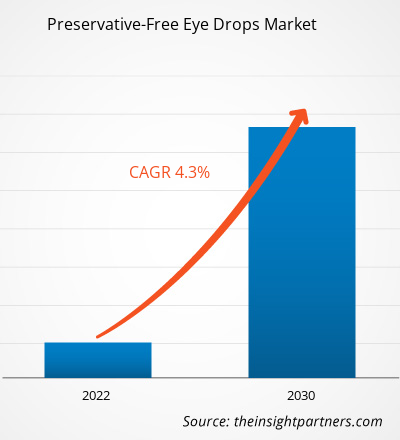预计无防腐剂眼药水市场规模将从 2024 年的 12.1 亿美元增至 2031 年的 16.3 亿美元,2025-2031 年期间的复合年增长率为 4.7%。CAGR of 4.7% during 2025–2031.
无防腐剂眼药水市场分析
慢性眼病患病率的上升、人们对防腐剂副作用的认识不断加深以及消费者偏好的转变,推动了市场的增长。包装技术的创新将在未来几年为无防腐剂眼药水市场创造充足的机遇。
无防腐剂眼药水市场概况
不含防腐剂的眼药水在眼部护理市场越来越受欢迎。人们越来越意识到眼药水中防腐剂的危害。此外,消费者更青睐不含化学成分且性质温和的产品,这一理念在无防腐剂配方的推广中发挥了重要作用。
北美无防腐剂眼药水市场在全球市场中处于领先地位,这得益于其庞大的医疗基础设施以及对眼药水中防腐剂潜在影响的认识。相比之下,亚太地区则由于医疗服务可及性的改善、人口老龄化以及可支配收入的提高而快速增长。因此,不同地区之间的增长速度很大程度上取决于人口趋势、医疗保健发展以及患者对无防腐剂眼药水的偏好。
您将获得任何报告的免费定制,包括本报告的部分内容、国家级分析、Excel 数据包,以及为初创企业和大学提供优惠和折扣
无防腐剂眼药水市场:战略洞察

-
获取此报告的顶级关键市场趋势。此免费样品将包括数据分析,从市场趋势到估计和预测。
无防腐剂眼药水市场驱动因素和机遇
市场驱动因素:
- 慢性眼病患病率上升:干眼症和青光眼等慢性眼病病例的增加,是无防腐剂眼药水需求不断增长的主要原因。事实上,患者正在寻求治疗效果较弱、不会对眼表造成进一步损害的长期治疗方案。
- 对防腐剂副作用的认识不断提高:随着患者和医生对防腐剂刺激性的认识不断提高,对不含防腐剂的眼药水的需求正在增加。
- 消费者偏好转变:消费者越来越多地选择不含防腐剂的产品,主要是出于对化学物质暴露和眼睛敏感的担忧。他们更倾向于天然、安全、无刺激的产品,这符合医疗保健领域整体化和以患者为中心的趋势。
市场机会:
- 包装技术创新:新技术对产品进行消毒和简化,例如机械过滤器和真空系统,用于不含防腐剂的眼药水,从而实现更安全的多剂量选择,满足创造市场的需求。
- 监管支持和临床建议:日益严格的监管和积极的临床建议将无防腐剂眼药水视为最安全的替代品;因此,市场采用的速度加快,创新的无防腐剂配方和输送系统获得了更容易的审批途径。
- 主要参与者的战略发展增加:创新产品、数字化流程、采用可持续包装和竞争是推动无防腐剂眼药水产品组合市场增长的四大战略,从而扩大其影响力。
无防腐剂眼药水市场报告细分分析
为了更清晰地了解无防腐剂眼药水市场运作方式、增长潜力和最新趋势,我们将市场细分为不同的细分市场。以下是大多数行业报告中使用的标准细分方法:
按类型:
- 单剂量:单剂量眼药水不含防腐剂,适合敏感和频繁使用者,因为它们易于使用且无污染。
- 多剂量:多剂量无防腐剂滴剂旨在保持其无菌性,保质期更长,并且可以轻松使用。
按应用:
- 干眼症 (DED):DED 是主要病因,而这又是温和、不含防腐剂的润滑眼药水流行的根源。
- 眼睛过敏/感染:不含防腐剂的滴眼液可为因过敏或感染引起的敏感眼睛提供最纯净的缓解。
- 青光眼:随着时间的推移,慢性青光眼的治疗通常会转向不含防腐剂的滴眼液,以尽量减少防腐剂对眼表造成的损伤。
- 视网膜疾病:不含防腐剂的药物为需要长期局部治疗的视网膜疾病的眼睛健康奠定了基础。
- 其他适应症:术后和隐形眼镜使用者这两类患者群体是安全眼药水无防腐剂的受益者。
按分销渠道:
- 医院药房
- 药店和零售药房
- 网上药店
按地理位置:
- 北美
- 欧洲
- 亚太地区
- 拉美
- 中东和非洲
北美无防腐剂眼药水市场预计将占据相当大的市场份额。干眼症和青光眼等慢性眼科疾病发病率的上升等因素可能会推动市场发展,尤其是在老年人群体中,并有望推动市场发展。
无防腐剂眼药水市场区域洞察
Insight Partners 的分析师已详尽阐述了预测期内影响无防腐剂眼药水市场的区域趋势和因素。本节还讨论了北美、欧洲、亚太地区、中东和非洲以及南美和中美洲的无防腐剂眼药水市场细分和地域分布。
无防腐剂眼药水市场报告范围
| 报告属性 | 细节 |
|---|---|
| 2024年的市场规模 | 12.1亿美元 |
| 2031年的市场规模 | 16.6亿美元 |
| 全球复合年增长率(2025-2031) | 4.7% |
| 史料 | 2021-2023 |
| 预测期 | 2025-2031 |
| 涵盖的领域 |
按类型
|
| 覆盖地区和国家 |
北美
|
| 市场领导者和主要公司简介 |
|
无防腐剂眼药水市场参与者密度:了解其对业务动态的影响
无防腐剂眼药水市场正在快速增长,这得益于终端用户需求的不断增长,而这些需求的驱动因素包括消费者偏好的不断变化、技术进步以及对产品益处的认知度不断提高。随着需求的增长,企业正在扩展产品线,不断创新以满足消费者需求,并抓住新兴趋势,从而进一步推动市场增长。

- 获取无防腐剂眼药水市场主要参与者的概述
无防腐剂眼药水市场份额按地区分析
预计未来几年亚太地区将增长最快。南美、中美、中东和非洲等新兴市场也为无防腐剂眼药水供应商提供了许多尚未开发的扩张机会。
由于监管机构和医疗指南对无防腐剂产品的建议,各地区无防腐剂眼药水市场的增长情况有所不同。以下是各地区市场份额和趋势的总结:
1. 北美
- 市场份额:占据全球市场的很大份额
- 关键驱动因素:技术先进的医疗保健系统、对防腐剂副作用的认识提高以及庞大的老年人口正在推动北美对不含防腐剂的眼药水的需求。
- 趋势:制造业进步和可持续实践
2.欧洲
- 市场份额:由于疼痛状况的日益普遍,市场份额大幅增加
- 关键驱动因素:监管机构建立强有力的无防腐剂眼药水监管框架的主要原因包括慢性眼科疾病的患病率不断上升以及患者对无防腐剂溶液的偏好日益增长。
- 趋势:监管对市场结构的影响
3. 亚太地区
- 市场份额:增长最快的地区,市场份额逐年上升
- 主要驱动因素:医疗保健服务的普及、老年人口的逐渐增长以及亚太市场可支配收入的稳步增长,共同推动了该地区不含防腐剂的眼药水的快速增长。
- 趋势:配方和交付方面的创新
4. 南美洲和中美洲
- 市场份额:市场稳步增长
- 关键驱动因素:南美洲和中美洲眼科疾病的增加和医疗保健基础设施的扩大是这些地区采用不含防腐剂的眼药水的主要驱动因素。
- 趋势:药品制造技术发展
5.中东和非洲
- 市场份额:虽然较小,但增长迅速
- 关键驱动因素:设备齐全的医疗保健行业和对眼部护理重要性的认识不断提高是中东和非洲地区对无防腐剂眼药水需求的两个主要原因。
- 趋势:治疗产品的增长
无防腐剂眼药水市场参与者密度:了解其对业务动态的影响
市场密度高,竞争激烈
由于爱尔康公司(Alcon AG)、博士伦公司(Bausch + Lomb Corporation)和拜耳公司(Bayer AG)等老牌企业的存在,竞争十分激烈。乐敦制药有限公司(Rohto Pharmaceutical Co., Ltd.)和Ursapharm Arzneimittel GmbH等区域性和利基供应商也加剧了不同地区的竞争格局。
这种激烈的竞争促使公司通过提供以下产品脱颖而出:
- 高级产品
- 定制和可持续解决方案等增值服务
- 有竞争力的定价模式
- 遵守监管准则
机遇与战略举措
- 企业在研发上的投入不断增加,推动了检测技术的创新,也提高了检测的灵敏度和特异性,从而解决了不同地区特有的眼部健康问题。
- 制造商可能会专注于本地生产以削减成本并加强供应链,尤其是在印度等大批量市场。
研究过程中分析的其他公司:
- 亿胜生物科技有限公司
- Pillar5制药公司
- 维齐亚
- 角膜护理公司
- 斯特里康
- 眼圈
- 阿普塔制药
- Ursapharm 制药有限公司
- 乐敦制药株式会社
- 喜马拉雅草药
无防腐剂眼药水市场新闻及最新发展
- 参天制药推出RYJUSEA Mini 0.025%滴眼液 日本首款延缓近视加深的滴眼液 参天制药株式会社宣布,已推出RYJUSEA Mini 0.025%滴眼液(有效成分:硫酸阿托品水合物,以下简称“本品”)。本品将作为国民健康保险药品价格标准中未收录药品销售,不在公共医疗保险范围内。
- 博士伦宣布发布 LUMIFY 无防腐剂红眼缓解眼药水的 3 期数据博士伦公司宣布,眼科和治疗学杂志已发布 3 期研究的结果,该研究评估了 LUMIFY 无防腐剂红眼缓解眼药水与 LUMIFY 红眼缓解眼药水在减少眼部红肿方面的有效性和安全性。
无防腐剂眼药水市场报告覆盖范围及交付成果
《无防腐剂眼药水市场规模和预测(2021-2031)》报告对以下领域进行了详细的市场分析:
- 不含防腐剂的眼药水市场规模以及全球、区域和国家层面所有主要细分市场的预测
- 无防腐剂眼药水市场趋势,以及市场动态,如驱动因素、限制因素和关键机遇
- 详细的 PEST 和 SWOT 分析
- 无防腐剂眼药水市场分析,涵盖主要市场趋势、全球和区域框架、主要参与者、法规和最新市场发展
- 行业格局和竞争分析,涵盖市场集中度、热图分析、知名参与者以及无防腐剂眼药水市场的最新发展
- 详细的公司简介
- 历史分析(2 年)、基准年、预测(7 年)及复合年增长率
- PEST和SWOT分析
- 市场规模、价值/数量 - 全球、区域、国家
- 行业和竞争格局
- Excel 数据集
近期报告
相关报告
客户评价
购买理由
- 明智的决策
- 了解市场动态
- 竞争分析
- 客户洞察
- 市场预测
- 风险规避
- 战略规划
- 投资论证
- 识别新兴市场
- 优化营销策略
- 提升运营效率
- 顺应监管趋势






















 获取免费样品 - 无防腐剂眼药水市场
获取免费样品 - 无防腐剂眼药水市场